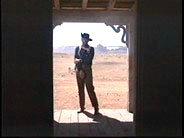 “The Searchers” had blatantly racist scenes and dialogue. Wayne’s character seems to be blood thirsty, driven to find his captured niece from a band of rogue Comanche.
“The Searchers” had blatantly racist scenes and dialogue. Wayne’s character seems to be blood thirsty, driven to find his captured niece from a band of rogue Comanche.
He views the Indians as ruthless and will kill them without a second thought. Although he is the most vocal of the group, his co-stars all seem to understand his view and attitudes, even if they don’t share all of them. He is driven to find his captured niece Debbie, who was kidnapped by marauding Comanches. Only thing is, he plans on killing Debbie once he finds her. She has been used by the “Comanche buck” as he says, so she doesn’t deserve to live. He also has a mysterious past, he is a ex- Confederate soldiers who never reveals how he rescued Martin Pawley or how he knows so much about Comanche and speaks their language.
The amazing thing about this particular Wayne vehicle is how much it alone influenced cinema and pop culture. In his review of the movie, Roger Ebert explains the reach of “The Seachers” influence. He says “Ethan's quest inspired a plot line in George Lucas' ''Star Wars.'' It's at the center of Martin Scorsese's ''Taxi Driver,'' written by Paul Schrader, who used it again in his own ''Hard Core.'' The hero in each of the Schrader screenplays is a loner driven to violence and madness by his mission to rescue a young white woman who has become the sexual prey of those seen as subhuman. Harry Dean Stanton's search for Nastassja Kinski in Wim Wenders' ''Paris, Texas'' is a reworking of the Ford story. Even Ethan's famous line ''That'll be the day'' inspired a song by Buddy Holly.” (Ebert, Roger Chicago Sun Times 11/2001)
During the early 1940’s, he was seen as hostile to Asians. America was at war with Japan, and the sentiment in America on a whole was the same as Wayne’s. He is seen as racist and still remains the hero of his movies.
One of these movies is “Sands Of Iwo Jima” The racist attitudes of the country during this time were clearly reflected in “Iwo Jima”. The tension between America and Japan resulted in movies that depicted America’s animosity toward our wartime enemy. The movie almost comes off as a war time pep rally on film, with the American’s fighting incredible odds and surviving.
It is interesting that Wayne plays basically the same character in this movie as in some of his earlier films. In “The Searchers” he plays sort of mystery man, with a definite military past. He continues to play the solider in “Iwo Jima” and several other movies.
John Wayne triva bit: ... The final scene of "The Searchers" was ad-libbed by Wayne as homage to good friend and fellow actor Harry Carey who had recently died. As Wayne stands in the doorway he grabs his right arms and stands there for a minute. This was Carey's signature stance. Thus the above picture.
Sunday, January 23, 2005
Due Process Is A Bullet Part 2
Posted by Q.Rock639 at 8:42 AM
Subscribe to:
Post Comments (Atom)














3 comments:
interesting how all of those story lines
grew out of the one from so long ago - just
goes to show how ideas and images affect the
minds of others and where it takes them
later in life...
for what class is this?
this is for american cinema. I figure I'll post a few papers to liven this blog up a bit.
Music reviews are next up.
This is Crystal Clear-couldn't sign in for some reason...anyway I wanted to commend you on such a well written and great piece. I had no idea there was so much linking all these movies. Great job!
http://crystal.typepad.com
Post a Comment